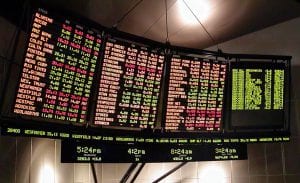
What Is Price to Sales Ratio?: Unveiling a Fundamental Investment Measure
April 24, 2024
Introduction:
In investing, the price-to-sales ratio (P/S ratio) is a crucial valuation metric that helps investors assess a company’s market value relative to its revenue. By comparing a company’s market capitalization to its annual sales, the P/S ratio provides insights into how much investors are willing to pay for each dollar of a company’s revenue. This article will explore the P/S ratio in depth, including its calculation, interpretation, advantages, limitations, and real-world examples.
Understanding the Price-to-Sales Ratio:
Definition and Calculation: The price-to-sales ratio is calculated by dividing a company’s market capitalization by its annual revenue. Market capitalization is the total market value of a company’s outstanding shares, calculated by multiplying the current stock price by the total number of shares outstanding. Annual revenue, also known as sales, can be found on a company’s income statement.
P/S Ratio = Market Capitalization / Annual Revenue
For example, if a company has a market capitalization of $1 billion and annual revenue of $500 million, its P/S ratio would be 2 ($1 billion / $500 million).
Interpretation:
A low P/S ratio suggests that investors pay less for each dollar of a company’s sales, which could indicate that the stock is undervalued. Conversely, a high P/S ratio implies that investors pay more for each sales dollar, potentially signalling an overvalued stock.
However, it’s essential to compare a company’s P/S ratio to its industry peers and its historical values to gain a more comprehensive understanding of its valuation. Different industries have varying average P/S ratios due to differences in growth prospects, profitability, and other factors.
Contrarian Perspectives on the P/S Ratio:
Niccolò Machiavelli, the renowned Italian philosopher and political theorist, would likely view the P/S ratio as a tool for understanding the perception and power dynamics between companies and investors. In his seminal work “The Prince,” Machiavelli emphasizes the importance of appearances and reputation in maintaining power and influence. He might argue that a high P/S ratio reflects a company’s ability to project an image of growth and success, attracting investors and solidifying its market position.
On the other hand, H.L. Mencken, the influential American journalist and satirist, would probably approach the P/S ratio with a more cynical perspective. Known for his biting critique of human behaviour and societal norms, Mencken might view the P/S ratio as a reflection of investors’ herd mentality and irrational exuberance. He could argue that high P/S ratios are driven by market sentiment rather than fundamental value, leading to potential bubbles and market inefficiencies.
Advantages of the P/S Ratio:
1. Useful for evaluating unprofitable companies: The P/S ratio can be beneficial when assessing companies that are not profitable or have inconsistent earnings. Since the ratio focuses on revenue rather than profits, investors can gauge the market’s perception of a company’s growth potential.
2. Simplicity: Compared to other valuation metrics, such as the price-to-earnings (P/E) ratio, the P/S ratio is relatively simple to calculate and understand. It requires only two inputs: market capitalization and annual revenue.
3. Less susceptible to accounting manipulations: Revenue is generally less prone to accounting manipulations than earnings, which can be affected by various accounting choices and one-time items. As a result, the P/S ratio may provide a more reliable valuation metric in some cases.
Limitations of the P/S Ratio:
1. Ignores profitability: The P/S ratio does not consider a company’s profitability or cost structure. A company with a low P/S ratio may appear undervalued, but it may not be attractive if it has poor profit margins or high expenses.
2. Vary significantly across industries: The average P/S ratio can vary widely. For example, technology companies often have higher P/S ratios than retail companies. Therefore, comparing P/S ratios across industries may not provide meaningful insights.
3. Sensitive to revenue fluctuations: The P/S ratio can be affected by short-term fluctuations in revenue, which may not reflect a company’s long-term prospects. This is particularly relevant for cyclical businesses or companies experiencing temporary challenges.
Real-World Examples:
Let’s look at some real-world examples to illustrate the application of the P/S ratio.
1. Amazon (AMZN): As of July 2021, Amazon had a market capitalization of approximately $1.8 trillion and annual revenue of $386 billion, resulting in a P/S ratio of around 4.7. This relatively high P/S ratio reflects investors’ confidence in Amazon’s growth prospects and dominant market position.
2. Walmart (WMT): As of July 2021, Walmart’s market capitalization was approximately $392 billion, and its annual revenue was $559 billion, resulting in a P/S ratio of about 0.7. Walmart’s low P/S ratio is typical for the retail industry, which generally has lower growth expectations and profit margins than other sectors.
3. Tesla (TSLA): As of July 2021, Tesla had a market capitalization of approximately $655 billion and annual revenue of $31.5 billion, resulting in a P/S ratio of around 20.8. Tesla’s high P/S ratio reflects investors’ expectations of significant future growth in the electric vehicle market and the company’s potential for technological innovation.
Expert Insights:
Aswath Damodaran, a renowned valuation expert and professor at New York University’s Stern School of Business, emphasizes the importance of considering a company’s growth prospects when interpreting the P/S ratio. In his book “Investment Valuation: Tools and Techniques for Determining the Value of Any Asset,” Damodaran states, “The price-sales ratio is a useful metric for valuing growth companies, where earnings may be negative or erratic, but it is also important to consider the quality of the revenue and the sustainability of growth.”
Michael Mauboussin, Director of Research at BlueMountain Capital Management, highlights the limitations of the P/S ratio in his research paper “What Does a Price-Earnings Multiple Mean?” He notes that “the price-sales ratio is an incomplete measure of value because it ignores differences in profitability across companies. Two companies with identical price-sales ratios can have very different economic characteristics.”
Conclusion:
The price-to-sales ratio is a valuable tool for investors to assess a company’s valuation relative to its revenue. By comparing market capitalization to annual sales, the P/S ratio provides insights into the market’s perception of a company’s growth potential. However, investors must be aware of the ratio’s limitations, such as its disregard for profitability and variability across industries.
When using the P/S ratio, it’s crucial to consider a company’s industry, growth prospects, profitability, and other relevant factors. Comparing a company’s P/S ratio to its peers and historical values can provide a more comprehensive understanding of its valuation.
Investors should combine the P/S ratio with other valuation metrics, such as the P/E ratio and price-to-book (P/B) ratio, and thoroughly analyse a company’s financial statements, competitive position, and prospects. By combining multiple valuation approaches and conducting thorough due diligence, investors can make more informed decisions when evaluating potential investments.
Engrossing Articles That Shed Light on Complex Topics
Valeant Shares Slump

End Of Bull Market: Masses Worry Higher Rates Will Kill This Bull
Why Global Warming Is A Hoax & How Oil Giants Are Feeling The Heat
Nuclear Waste Management Market
Commodities Increased in April
Chinese Renminbi bullish long term outlook or Demise
Netherlands to Ban Gasoline-Powered Cars By 2025
Fossil Fuel Divestment Trends gain momentum
Tyrant Erdogan seizes six churches
Negative Interest Rates Fantastic For Speculators
Plunging battery prices set to fuel surge in demand for EV’s
Media Manipulation; The Fraudulent Economic Recovery
Shanghai se Composite Index & The Margin Trading Story
Federal Reserve existence based on Fraud
Share Buybacks Deception- Corporate Share Buybacks Keeping Dow Bull Alive
Investing for Teenagers: Laying the Foundation for a Financially Stable Future


